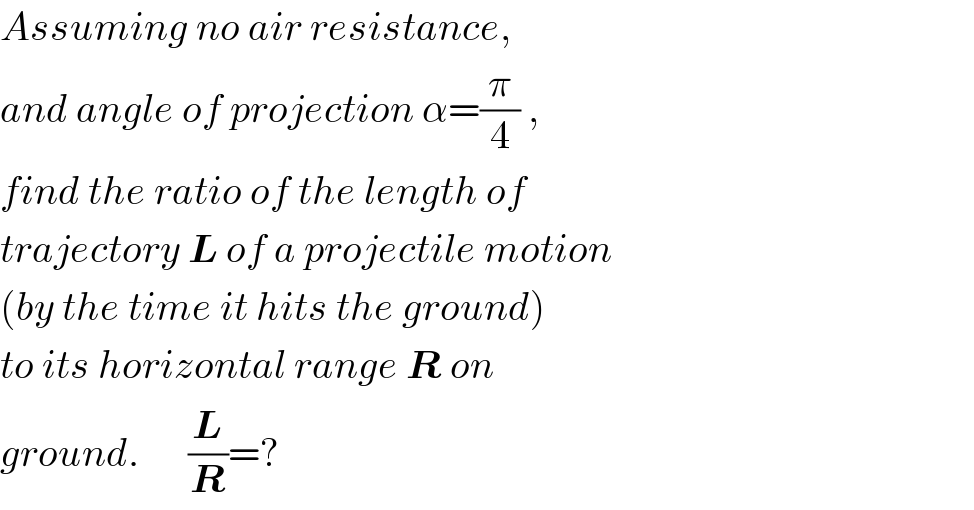
Question Number 13705 by ajfour last updated on 22/May/17

$${Assuming}\:{no}\:{air}\:{resistance}, \\ $$$${and}\:{angle}\:{of}\:{projection}\:\alpha=\frac{\pi}{\mathrm{4}}\:, \\ $$$${find}\:{the}\:{ratio}\:{of}\:{the}\:{length}\:{of} \\ $$$${trajectory}\:\boldsymbol{{L}}\:{of}\:{a}\:{projectile}\:{motion}\: \\ $$$$\left({by}\:{the}\:{time}\:{it}\:{hits}\:{the}\:{ground}\right) \\ $$$${to}\:{its}\:{horizontal}\:{range}\:\boldsymbol{{R}}\:{on}\: \\ $$$${ground}.\:\:\:\:\:\:\frac{\boldsymbol{{L}}}{\boldsymbol{{R}}}=? \\ $$
Commented by ajfour last updated on 22/May/17

Commented by mrW1 last updated on 22/May/17
![for parabola f(x)=ax^2 the length of the curve from x=0 to x=b is l=∫_0 ^b (√(1+((dy/dx))^2 ))dx =∫_0 ^b (√(1+(2ax)^2 ))dx =(1/(2a))∫_0 ^(2ab) (√(1+t^2 ))dt =(1/(4a))[t(√(1+t^2 ))+ln (t+(√(1+t^2 )))]_0 ^(2ab) =(b/2)×(1/(2ab))(2ab(√(1+(2ab)^2 ))+ln (√(1+(2ab)^2 ))) apply this in our case: b=(R/2) height of parabola h is h=(R/4)×tan α_0 =(R/4)×tan (π/4)=(R/4) h=a((R/2))^2 =a(R^2 /4)=(R/4) ⇒a=(1/R) 2ab=2×(1/R)×(R/2)=1 ⇒L=2×(R/4)×(1/1)×[1×(√(1+1^2 ))+ln (1+(√(1+1^2 )))]=(R/2)×[(√2)+ln (1+(√2))] ⇒(L/R)=(((√2)+ln (1+(√2)))/2)≈1.15](Q13718.png)
$${for}\:{parabola}\:{f}\left({x}\right)={ax}^{\mathrm{2}} \\ $$$${the}\:{length}\:{of}\:{the}\:{curve}\:{from}\:{x}=\mathrm{0}\:{to} \\ $$$${x}={b}\:{is} \\ $$$${l}=\int_{\mathrm{0}} ^{{b}} \sqrt{\mathrm{1}+\left(\frac{{dy}}{{dx}}\right)^{\mathrm{2}} }{dx} \\ $$$$=\int_{\mathrm{0}} ^{{b}} \sqrt{\mathrm{1}+\left(\mathrm{2}{ax}\right)^{\mathrm{2}} }{dx} \\ $$$$=\frac{\mathrm{1}}{\mathrm{2}{a}}\int_{\mathrm{0}} ^{\mathrm{2}{ab}} \sqrt{\mathrm{1}+{t}^{\mathrm{2}} }{dt} \\ $$$$=\frac{\mathrm{1}}{\mathrm{4}{a}}\left[{t}\sqrt{\mathrm{1}+{t}^{\mathrm{2}} }+\mathrm{ln}\:\left({t}+\sqrt{\mathrm{1}+{t}^{\mathrm{2}} }\right)\right]_{\mathrm{0}} ^{\mathrm{2}{ab}} \\ $$$$=\frac{{b}}{\mathrm{2}}×\frac{\mathrm{1}}{\mathrm{2}{ab}}\left(\mathrm{2}{ab}\sqrt{\mathrm{1}+\left(\mathrm{2}{ab}\right)^{\mathrm{2}} }+\mathrm{ln}\:\sqrt{\mathrm{1}+\left(\mathrm{2}{ab}\right)^{\mathrm{2}} }\right) \\ $$$$ \\ $$$${apply}\:{this}\:{in}\:{our}\:{case}: \\ $$$${b}=\frac{{R}}{\mathrm{2}} \\ $$$${height}\:{of}\:{parabola}\:{h}\:{is} \\ $$$${h}=\frac{{R}}{\mathrm{4}}×\mathrm{tan}\:\alpha_{\mathrm{0}} =\frac{{R}}{\mathrm{4}}×\mathrm{tan}\:\frac{\pi}{\mathrm{4}}=\frac{{R}}{\mathrm{4}} \\ $$$${h}={a}\left(\frac{{R}}{\mathrm{2}}\right)^{\mathrm{2}} ={a}\frac{{R}^{\mathrm{2}} }{\mathrm{4}}=\frac{{R}}{\mathrm{4}} \\ $$$$\Rightarrow{a}=\frac{\mathrm{1}}{{R}} \\ $$$$\mathrm{2}{ab}=\mathrm{2}×\frac{\mathrm{1}}{{R}}×\frac{{R}}{\mathrm{2}}=\mathrm{1} \\ $$$$ \\ $$$$\Rightarrow{L}=\mathrm{2}×\frac{{R}}{\mathrm{4}}×\frac{\mathrm{1}}{\mathrm{1}}×\left[\mathrm{1}×\sqrt{\mathrm{1}+\mathrm{1}^{\mathrm{2}} }+\mathrm{ln}\:\left(\mathrm{1}+\sqrt{\mathrm{1}+\mathrm{1}^{\mathrm{2}} }\right)\right]=\frac{{R}}{\mathrm{2}}×\left[\sqrt{\mathrm{2}}+\mathrm{ln}\:\left(\mathrm{1}+\sqrt{\mathrm{2}}\right)\right] \\ $$$$\Rightarrow\frac{{L}}{{R}}=\frac{\sqrt{\mathrm{2}}+\mathrm{ln}\:\left(\mathrm{1}+\sqrt{\mathrm{2}}\right)}{\mathrm{2}}\approx\mathrm{1}.\mathrm{15} \\ $$
Commented by ajfour last updated on 22/May/17

$${thank}\:{you}\:{Sir},\:{our}\:{answers}\:{even} \\ $$$${match}! \\ $$
Answered by ajfour last updated on 22/May/17
![dL=(√(1+((dy/dx))^2 )) dx dy=(usin α−gt)dt dx=(ucos α)dt (dy/dx)=(((usin α−gt)/(ucos α))) ∫_0 ^( L) dL=∫_0 ^( T) (√(1+(((usin α−gt)/(ucos α)))^2 ))(ucos α)dt for y component of motion v_y =usin 𝛂−gt =0 for t=(T/2) ⇒ T=((2usin 𝛂)/g) for 𝛂=(𝛑/4) , T=((u(√2))/g) .....(i) L=(u/(√2))∫_0 ^( u(√2)/g) (√(1+(1−((gt(√2))/u))^2 ))dt let p=1−((gt(√2))/u) dp=−((g(√2))/u)dt ⇒ dt=−(u/(g(√2)))dp when t=0, p=1 when t=((u(√2))/g) , p=−1 ∴ L=(u/(√2))∫_1 ^( −1) (√(1+p^2 ))(−(u/(g(√2))))dp L=(u^2 /g)∫_0 ^( 1) (√(1+p^2 ))dp L=(u^2 /g)[(p/2)(√(1+p^2 ))+(1/2)ln (p+(√(1+p^2 )))]_0 ^1 L=(u^2 /(2g))[(√2)+ln (1+(√2))] R=(ucos 𝛂)T =(u/(√2)) ((u(√2))/g)=(u^2 /g) so, (L/R)=(((√2)+ln (1+(√2)))/2) ≈1.148](Q13719.png)
$${dL}=\sqrt{\mathrm{1}+\left(\frac{{dy}}{{dx}}\right)^{\mathrm{2}} }\:{dx} \\ $$$${dy}=\left({u}\mathrm{sin}\:\alpha−{gt}\right){dt} \\ $$$${dx}=\left({u}\mathrm{cos}\:\alpha\right){dt} \\ $$$$\frac{{dy}}{{dx}}=\left(\frac{{u}\mathrm{sin}\:\alpha−{gt}}{{u}\mathrm{cos}\:\alpha}\right) \\ $$$$\int_{\mathrm{0}} ^{\:\:\boldsymbol{{L}}} {dL}=\int_{\mathrm{0}} ^{\:\:\boldsymbol{{T}}} \sqrt{\mathrm{1}+\left(\frac{{u}\mathrm{sin}\:\alpha−{gt}}{{u}\mathrm{cos}\:\alpha}\right)^{\mathrm{2}} }\left({u}\mathrm{cos}\:\alpha\right){dt} \\ $$$${for}\:{y}\:{component}\:{of}\:{motion} \\ $$$$\boldsymbol{{v}}_{\boldsymbol{{y}}} =\boldsymbol{{u}}\mathrm{sin}\:\boldsymbol{\alpha}−{gt} \\ $$$$\:\:\:\:\:=\mathrm{0}\:\:\:{for}\:\:{t}=\frac{{T}}{\mathrm{2}} \\ $$$$\Rightarrow\:\boldsymbol{{T}}=\frac{\mathrm{2}\boldsymbol{{u}}\mathrm{sin}\:\boldsymbol{\alpha}}{\boldsymbol{{g}}} \\ $$$${for}\:\:\boldsymbol{\alpha}=\frac{\boldsymbol{\pi}}{\mathrm{4}}\:\:,\:\:{T}=\frac{\boldsymbol{{u}}\sqrt{\mathrm{2}}}{\boldsymbol{{g}}}\:\:\:\:.....\left(\boldsymbol{{i}}\right) \\ $$$$\boldsymbol{{L}}=\frac{{u}}{\sqrt{\mathrm{2}}}\int_{\mathrm{0}} ^{\:\:{u}\sqrt{\mathrm{2}}/{g}} \sqrt{\mathrm{1}+\left(\mathrm{1}−\frac{{gt}\sqrt{\mathrm{2}}}{{u}}\right)^{\mathrm{2}} }{dt} \\ $$$$\:\:\:{let}\:\:\boldsymbol{{p}}=\mathrm{1}−\frac{\boldsymbol{{gt}}\sqrt{\mathrm{2}}}{\boldsymbol{{u}}} \\ $$$$\:\:\boldsymbol{{dp}}=−\frac{\boldsymbol{{g}}\sqrt{\mathrm{2}}}{\boldsymbol{{u}}}\boldsymbol{{dt}}\:\:\:\Rightarrow\:{dt}=−\frac{\boldsymbol{{u}}}{\boldsymbol{{g}}\sqrt{\mathrm{2}}}\boldsymbol{{dp}} \\ $$$${when}\:{t}=\mathrm{0},\:\:\boldsymbol{{p}}=\mathrm{1} \\ $$$${when}\:{t}=\frac{{u}\sqrt{\mathrm{2}}}{{g}}\:,\:\:\boldsymbol{{p}}=−\mathrm{1} \\ $$$$\therefore\:\boldsymbol{{L}}=\frac{{u}}{\sqrt{\mathrm{2}}}\int_{\mathrm{1}} ^{\:\:−\mathrm{1}} \sqrt{\mathrm{1}+\boldsymbol{{p}}^{\mathrm{2}} }\left(−\frac{\boldsymbol{{u}}}{\boldsymbol{{g}}\sqrt{\mathrm{2}}}\right)\boldsymbol{{dp}} \\ $$$$\boldsymbol{{L}}=\frac{\boldsymbol{{u}}^{\mathrm{2}} }{\boldsymbol{{g}}}\int_{\mathrm{0}} ^{\:\:\mathrm{1}} \sqrt{\mathrm{1}+\boldsymbol{{p}}^{\mathrm{2}} }\boldsymbol{{dp}} \\ $$$$\boldsymbol{{L}}=\frac{\boldsymbol{{u}}^{\mathrm{2}} }{\boldsymbol{{g}}}\left[\frac{\boldsymbol{{p}}}{\mathrm{2}}\sqrt{\mathrm{1}+\boldsymbol{{p}}^{\mathrm{2}} }+\frac{\mathrm{1}}{\mathrm{2}}\mathrm{ln}\:\left(\boldsymbol{{p}}+\sqrt{\mathrm{1}+\boldsymbol{{p}}^{\mathrm{2}} }\right)\right]_{\mathrm{0}} ^{\mathrm{1}} \\ $$$$\boldsymbol{{L}}=\frac{\boldsymbol{{u}}^{\mathrm{2}} }{\mathrm{2}\boldsymbol{{g}}}\left[\sqrt{\mathrm{2}}+\mathrm{ln}\:\left(\mathrm{1}+\sqrt{\mathrm{2}}\right)\right] \\ $$$$\boldsymbol{{R}}=\left(\boldsymbol{{u}}\mathrm{cos}\:\boldsymbol{\alpha}\right)\boldsymbol{{T}} \\ $$$$\:\:\:\:=\frac{\boldsymbol{{u}}}{\sqrt{\mathrm{2}}}\:\frac{\boldsymbol{{u}}\sqrt{\mathrm{2}}}{\boldsymbol{{g}}}=\frac{\boldsymbol{{u}}^{\mathrm{2}} }{\boldsymbol{{g}}} \\ $$$$\boldsymbol{{so}},\:\:\frac{\boldsymbol{{L}}}{\boldsymbol{{R}}}=\frac{\sqrt{\mathrm{2}}+\mathrm{ln}\:\left(\mathrm{1}+\sqrt{\mathrm{2}}\right)}{\mathrm{2}}\:\approx\mathrm{1}.\mathrm{148} \\ $$
